Things to do in Hampi - UNESCO World Heritage Site
Hampi was the ancient capital city of the Vijayanagara Kingdom of South India in the 14th century AD. It is located in the Ballari district of Karnataka and today, is home to the Hampi Group of Monuments, a UNESCO World Heritage Site. The place is dotted with ruins of all kinds: temples, palaces, private baths, elephant stables, and much more! Sometimes it can get overwhelming on what to see and what to miss, especially if you are a first-timer. If you are in a similar predicament about what to do on a trip to Hampi, then you must read this.
Here’s a list of things that your trip to Hampi should definitely include.
Hampi is like a novel written in stones. Huge boulders and rocky mountains dot an arid landscape. The scenery is mostly a mix of blue and brown interrupted by moments of green. In the middle of all this, you spot precious temples and pillared mandapas carved out of local granite giving the entire place an austerely exquisite feeling.
You cannot help but wonder why the Rayas of the Vijayanagara Empire chose to build their capital here. The answer comes right out of my Class 7th history book. The location of Hampi was strategic. It was bordered by Tungabhadra on one side and cliffs on the other three. No doubt, it made an invincible capital.
If you are planning a trip to Hampi and are looking for the perfect itinerary, then why not have a look at the highlights of my recent trip to this beautiful place. We covered Hampi in 2 complete days and this is the best of what my itinerary included.
Explore the Vijaya Vittala Temple and its Musical Pillars
A visit to the Vijaya Vittala Temple was my favorite thing in Hampi. Exploring the intricate carvings and the famous musical pillars of this iconic temple was the most exciting thing I did on this trip. Vijaya Vittala houses a chariot-shaped temple in the courtyard which has been inspired by the Sun Temple at Konark. The temple is utterly magical and a must-do for every tourist – new and old.
Be amazed by the King’s Balance
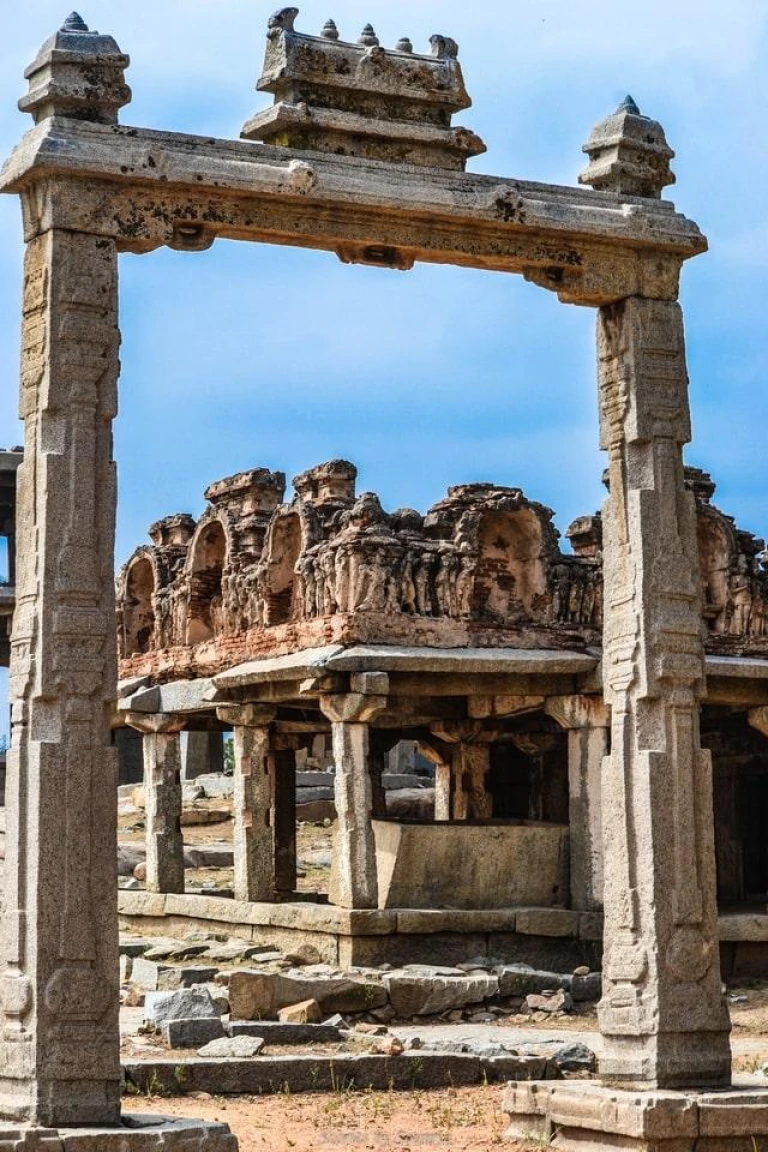 The King’s Balance at Hampi
The King’s Balance at Hampi
Behind the Vijaya Vittala Temple lie the remains of numerous other temples easily accessible by a dusty trail. Walk a few minutes on this trail and you will be face-to-face with an imposing frame that supposedly functioned as the King’s balance in the olden days. On days of celebration, the King would sit on one side of the balance while grains and gold would be weighed on the other and distributed amongst the king’s subjects.
Go for a coracle ride on the Tungabhadra
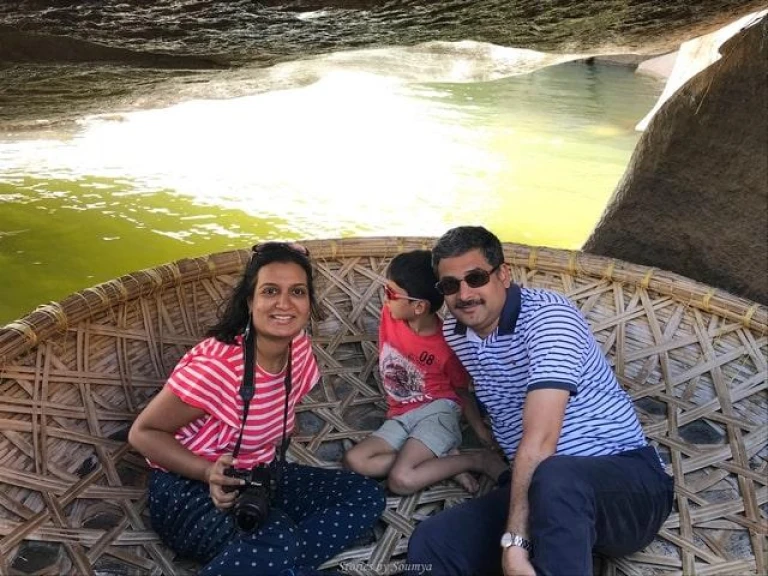 On the coracle in Hampi
On the coracle in Hampi
An interesting and adventurous thing to do on a trip to Hampi is to go for a coracle ride on the Tungabhadra. Coracles are round boats made of bamboo and plastic and are steered by a helmsman. At a place called Chakratirtha, you can ride a coracle, enjoy the breeze, and explore some beautiful, rock-cut temples on the river flanks.
Visit the Virupaksha Temple for its stunning murals
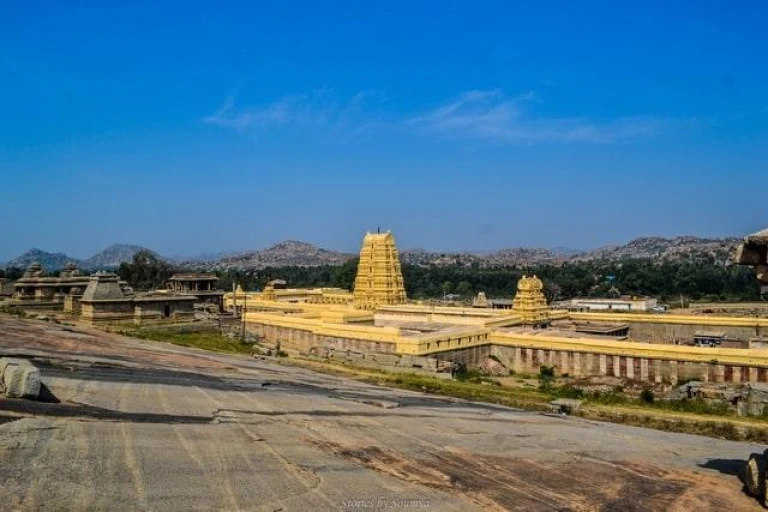 One of the best things to do in Hampi – visit Virupaksha Temple.
One of the best things to do in Hampi – visit Virupaksha Temple.
The Virupaksha Temple is one of the most important temples in Hampi. The shrine has been around since the 7th century but got its current form sometime in the 15th century. Worship is still offered here. What I found really striking about this temple were the murals from centuries ago that adorn the ceilings of the Ranga Mandapas. Here, you will also find the idol of a 3-headed Nandi bull (unique to only this temple in India) and intricate carvings all over the walls and pillars.
Spend some time at the Hemakuta Group of Temples
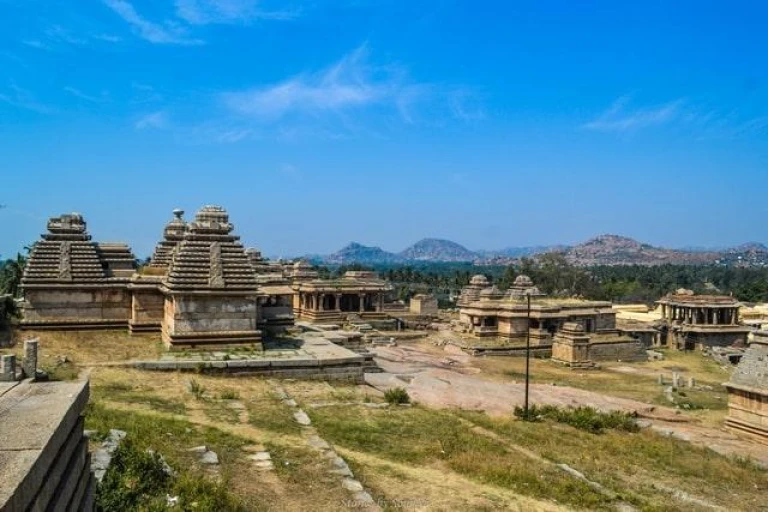 Hemakuta Temples – also known as the Jain Temples of Hampi
Hemakuta Temples – also known as the Jain Temples of Hampi
The Hemakuta Group of Temples are located on a hill right behind the Virupaksha Temple. It is a cluster of smaller temples, more than 35 to be precise, mostly dedicated to Lord Shiva. Very often, they are referred to as Jain Temples of Hampi because of architecture similar to Jain temples of Western India. Exploring these in detail can take close to 3 hours.
Drop by the Sasivekalu and the Kadalekalu Ganeshas
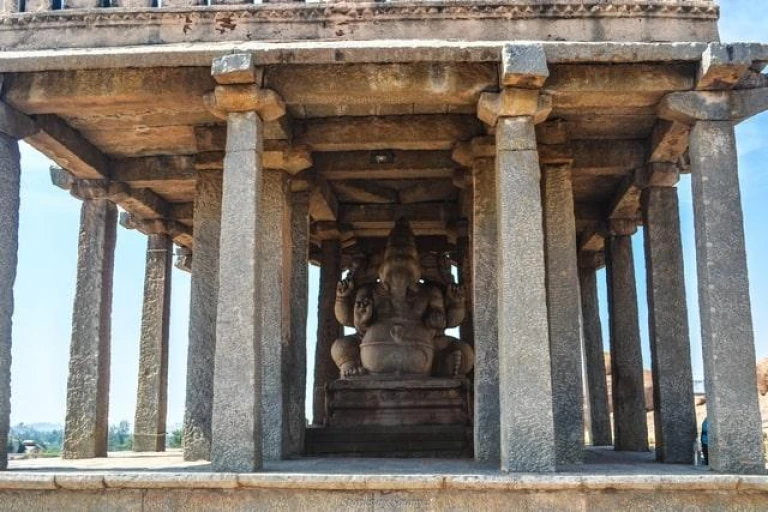 Sasivekalu Ganesha
Sasivekalu Ganesha
Hampi has two famous Ganesha (Hindu God of Wisdom) idols that nobody ever misses on a trip to Hampi. Sasivekalu Ganesha is a huge idol made out of a single rock. This temple is located at the southern side of the Hemakuta Hill. A few minutes away is the temple of Kadalekalu Ganesha that is yet another huge statue of the deity. The sheer size of the idols and the monolithic origins are impressive.
Discover some lost connections at the Krishna Temple
Any trip to Hampi mandates a visit to the ancient Krishna Temple. And that is because of the beauty that the temple itself is. It has some spectacular carvings that are not to be found elsewhere in Hampi. And those temple tops (pictured above) vaguely reminded me of Khmer architecture in Cambodia and Thailand. Was there a connection between the two? Maybe we could find out!
Have a filling lunch at Mango Tree
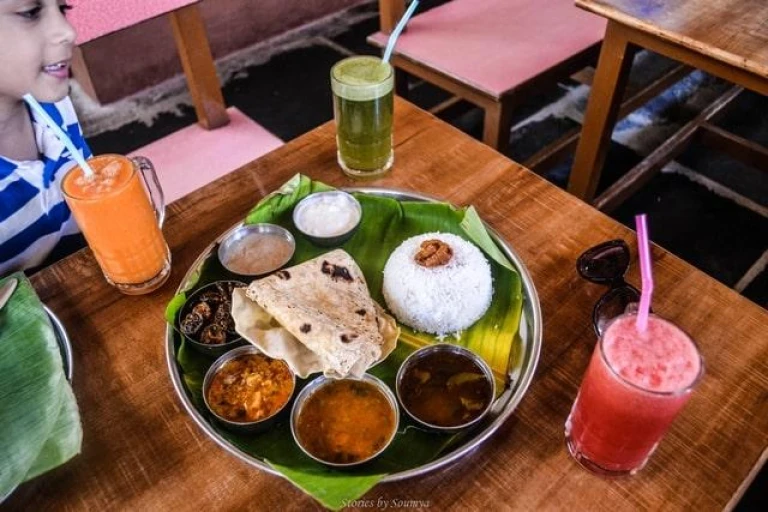 Where to eat in Hampi – Mango Tree Restaurant
Where to eat in Hampi – Mango Tree Restaurant
If you are looking for the best place to eat in Hampi, then I have got your back. Mango Tree, Hampi’s favorite restaurant, is located in the midst of the Hampi Bazaar right in front of the Virupaksha Temple. It serves continental items too in addition to the usual Indian fare. And their fresh fruit juices are extremely good. It is difficult to find non-vegetarian food in Hampi. However, I found a really yummy Anda Bhurji (variation of scrambled eggs) at Mango Tree.
Visit the Lotus Mahal and the Elephant Stables
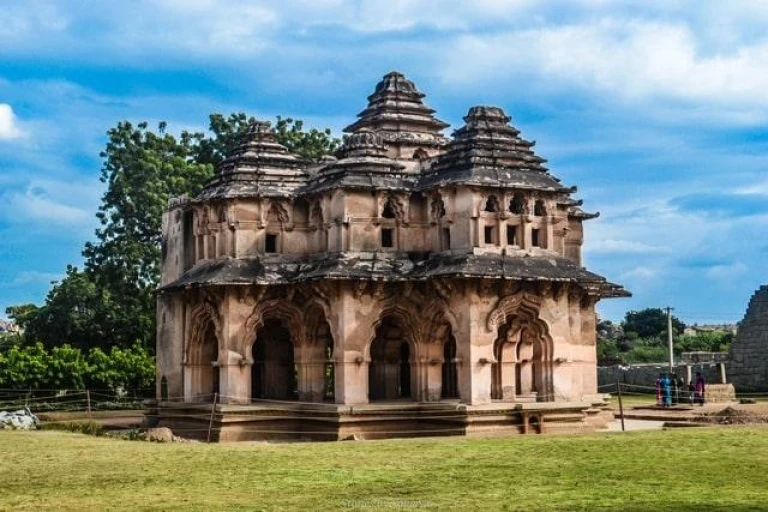 Must-do on a trip to Hampi – A visit to Lotus Mahal
Must-do on a trip to Hampi – A visit to Lotus Mahal
The Lotus Mahal or the Kamal Mahal is one of the most attractive monuments within the “Zenana Enclosure” in Hampi. The Zenana Enclosure is an area that was exclusively reserved for the women of Vijayanagara Empire. And the Lotus Mahal is its center of attraction. The architecture of this building is quite different from the others in the vicinity and with its domes and beautiful archways, it almost resembles a half-opened lotus.

Any trip to Hampi is incomplete without a tour of the Royal Elephant Stables. There are about 11 domed chambers that were used to house royal elephants. Intricate carvings dominate the upper half of the arched doorways. The place looks pretty almost like a beautiful necklace. It is quite evident that the king was fond of his animals.
Take a walk around the Royal Enclosure
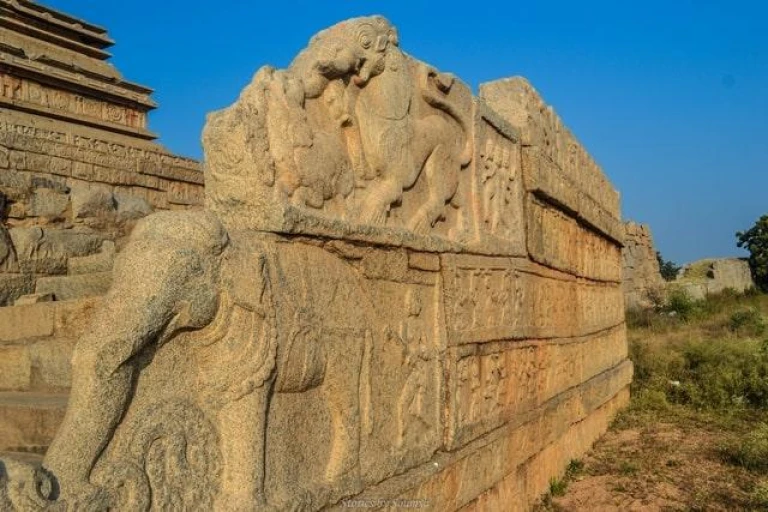
A walk around Hampi’s Royal Enclosure is a must-do on any Hampi itinerary. Here you can view the base of the Royal Palace with interesting friezes on it, ornate platforms that were used for entertainment and dances, and a small, inconspicuous labyrinth that was used to hide the king when there were enemies around. An interesting set of monuments dot the area and you are sure to find some intriguing stories here.
Check out the Hampi Stepwells
I had recently seen the stepwells of Gujarat and needless to say, I had been impressed. A stepwell near the Hampi royal palace could only entice me to see more. It was huge.
The stepwell was not as elaborate as the ones from Western India but the size and the structure were impressive. It was made of black granite and shone in the sun. But it had none of the carvings and small shrines that the ones in Gujarat and Rajasthan had.
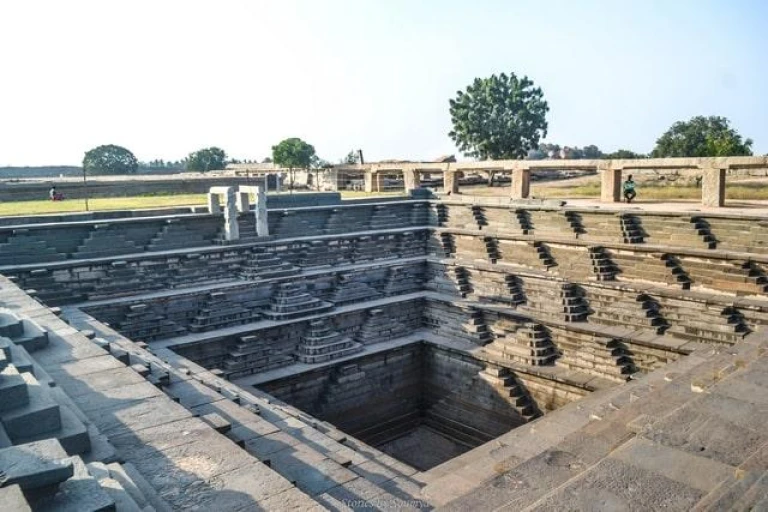 Stepwells of a different kind in Hampi
Stepwells of a different kind in Hampi
Stepwells in Hampi are called Purshkarinis, tanks built for religious purposes. Small tip: There is another Pushkarini near the Vijaya Vittala Temple made up of white marble that is equally pretty.
Stepwells from Northwestern India date from long ago with a number of elaborate ones being constructed between the 11th – 15th centuries. The ones in Hampi were probably built around the same time or later but are less elaborate, more functional. It is hard not to think of a connection. Would love to learn more if anyone has some ideas.
View the ancient city of Hampi from a vantage point
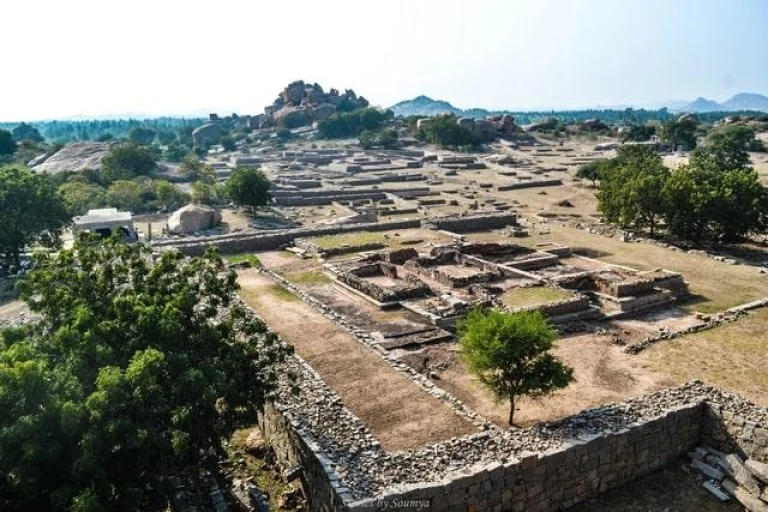 Get some of the best views of Hampi
Get some of the best views of Hampi
Getting a view of the lost city of Hampi from a raised platform has its own charm. There are a few elevated points in and around the ruins from where you can get a royal view of the residences and guest rooms. The Lotus Mahal and the Elephant stables are also visible in the distance. A view like the one above was a treat to my eyes and soul. Who knows who lived in those rooms, walked through those corridors, and laughed in those gardens! We can only imagine.
Get lost in the solitude of it all
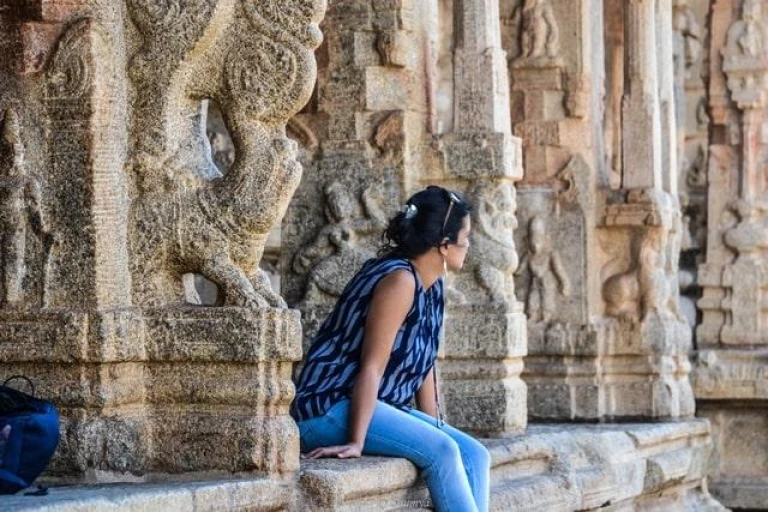
Hampi is not as crowded as the Taj Mahal or the Gateway of India, the reason being a general lack of accessibility and awareness. The only visitors here seemed to be from Goa, the rest of Karnataka, or Mumbai. There is another more interesting group of monuments nearby at Aihole, Badami, and Pattadakal (a UNESCO World Heritage) which is even less frequented. So, it’s possible to find entire temples for yourself. I loved those moments of solitude among the beautiful stones.
How To Get To Hampi
You can get to Hampi from Mumbai or Bangalore. We took a flight from Mumbai to Bangalore and then boarded the Hampi Express from Yelahanka Junction – Railway Station in Bangalore. That got us till Hospet and we stayed in Hospet a couple of days and explored Hampi. Hampi is about an hour’s ride from Hospet. And Hospet provides better accommodation and eating options.
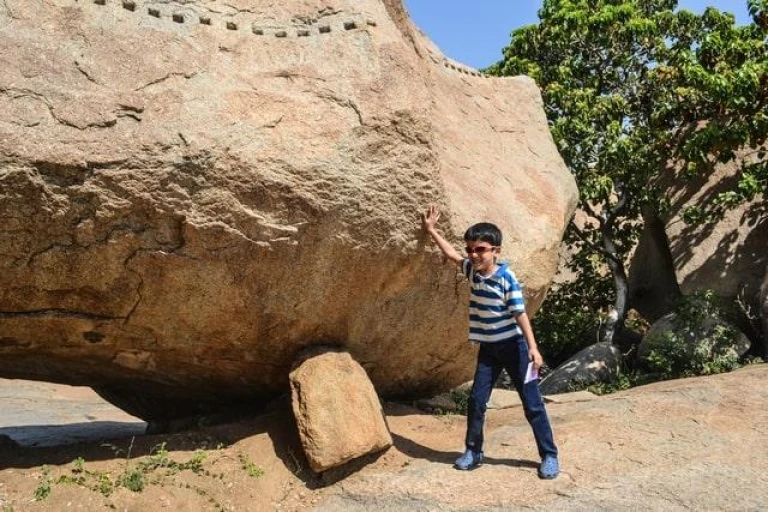
Best Time To Visit Hampi
The best time to visit Hampi or anywhere close by is between November – February. December and January are the peak traffic months. It gets exceptionally hot in the summers and therefore, summer is definitely not a good time to visit. Even during winters, the sun can be harsh. Hampi is an open museum and there is not much cover from the heat. So, always carry sufficient water, sunscreen, and your hat.
Hampi is a beautiful place. A trip to Hampi was my way of putting to rest a wanderlust that had been triggered long back in middle school when I had spotted the chariot temple of Vijaya Vittala in one of my textbooks. I would love to go back to this beautiful place one day to make more memories.
Published at
About Author
Sourav
Subscribe our Newsletter
Get our weekly tips and travel news!
Related Posts
Latest Posts
You don't Need FASTag anymore? Everything you need to know!
No more FASTag from May 1st?
10 Dreamy Experiences for Couples in Kashmir
Fancy some romantic experiences in Kashmir?
How much will a trip to Indonesia cost from India? Travel Budget Guide
Need to budget a tropical getaway from India to Indonesia?
Indian Traveler's 7 Day Itinerary for Island Hopping in Indonesia
Your perfect Indonesian island getaway guide is here!
Best 4-Day Itinerary for Kashmir, India
Ready to fall in love with Kashmir in just four days?

